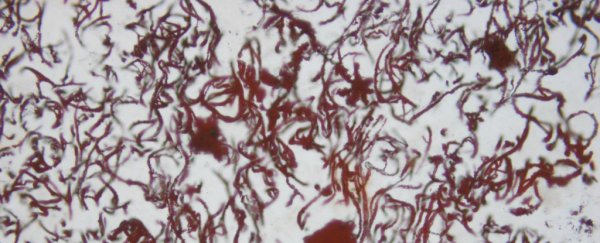Scientists have discovered what appears to be tiny microorganism remains preserved in quartz in Canada, and have dated them to a whopping 3.77 billion years ago.
This ancient find is believed to be the oldest fossil ever discovered, and could help us understand how life came to be on Earth, and what organisms could look like on other planets.
"Our discovery supports the idea that life emerged from hot, seafloor vents shortly after planet Earth formed," said one of the team, Matthew Dodd, from the University College London.
"This speedy appearance of life on Earth fits with other evidence of recently discovered 3,700 million year old sedimentary mounds that were shaped by microorganisms."
In case you need a quick rundown on how life originated, the current hypothesis is that we formed from organic compounds at the bottom of the ocean between 3.8 and 4.1 billion years ago.
At some point after that, around 3.5 to 3.8 billion years ago, the Last Universal Common Ancestor lived, and its descendants split off into precursors for the three domains of life we see today: archaea, bacteria, and eukarya - which we belong to. But the details are still fuzzy.
What makes this new find so special is that it's so old - right from the beginnings of life - so it could help scientists narrow down once and for all how and when the first life originated on our pale blue dot.
The oldest fossils before this were found in Western Australia, and dated at approximately 3.46 billion years, but there has been debate within scientific circles over whether they actually represent the remains of living organisms.
The fossilised remains found in Canada were not very complex, but still hint at life - tiny filaments and tubes that appear to have been formed by bacteria that grew and fed on iron.
The fossils were encased in layers of quartz in the Nuvvuagittuq Supracrustal Belt on the eastern shore of Hudson Bay, about 40 km southeast of Inukjuak in Quebec.
That location contains some of the oldest sedimentary rocks on Earth, and the scientists think that the rocks formed in an iron-rich deep-sea hydrothermal vent system - a habitat for Earth's oldest lifeforms.
They investigated the filaments and tubes, and determined that the fossils were formed by a process called putrefaction - the decaying of biological matter - suggesting they were likely produced by living organisms.
"The fact we unearthed them from one of the oldest known rock formations, suggests we've found direct evidence of one of Earth's oldest lifeforms," said one of the UCL team, Dominic Papineau.
"This discovery helps us piece together the history of our planet and the remarkable life on it, and will help to identify traces of life elsewhere in the universe."
Plus it could even help us find fossils of life on other planets.
"These discoveries demonstrate life developed on Earth at a time when Mars and Earth had liquid water at their surfaces, posing exciting questions for extra-terrestrial life," said Dodd.
"Therefore, we expect to find evidence for past life on Mars 4,000 million years ago, or if not, Earth may have been a special exception."
But not everyone is convinced, with some scientists saying that the team's hypothesis is just not believable.
"Every statement in the paper is hedged. No normally sceptical scientist can accept the evidence as presented," Malcolm Walter, founding director of the Australian Centre for Astrobiology, told The Sydney Morning Herald.
"They haven't proved these structures are of biological origin," added Martin Van Kranendonk from the University of New South Wales. "The rocks in which they have been found are strongly recrystalised."
We're looking forward to seeing who's right.
The research has been published in Nature.
